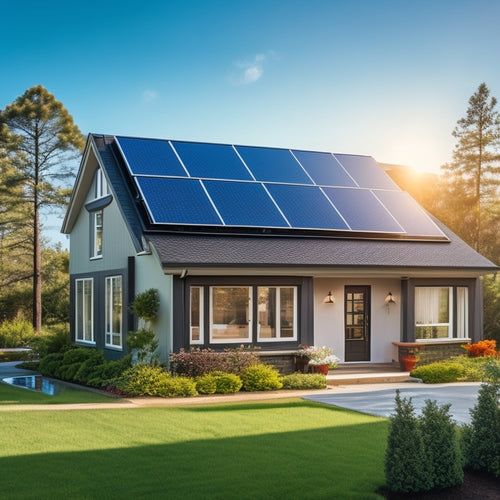
What Are the Essential Components Affecting Small House Solar System Cost
Share
When determining the cost of a small house solar system, you'll need to evaluate several essential components. The system's size and complexity, as well as roof size and orientation, impact installation complexity and costs. The type and quality of panels, inverter efficiency, and mounting and installation costs also affect the overall expense. In addition, battery backup and storage, charge controller and monitoring, and local labor and installation factors contribute to the final cost. Moreover, permits and inspection fees, as well as local regulatory and financial considerations, must be taken into account. As you investigate these factors, you'll gain a deeper understanding of the costs involved.
Key Takeaways
- System size and complexity, including installation obstacles and additional components, significantly impact overall solar system costs.
- Roof size and orientation, as well as local climate and zoning regulations, affect solar access and system performance.
- Type and quality of solar panels, inverters, and battery backup systems influence energy output, efficiency, and lifespan.
- Installation factors, including mounting costs, labor costs, and permits, vary based on roof type, local labor market rates, and regulatory requirements.
- Local regulations, permits, and inspection fees, as well as installation labor costs, contribute to the overall cost of a small house solar system.
System Size and Complexity
How much of an impact does the size and complexity of your solar system have on the overall cost? The answer lies in your energy needs and the system design that meets those needs. A larger system with more panels and a higher capacity will naturally cost more than a smaller one.
However, it's not just the number of panels that affects the cost. The complexity of the system design also plays a significant role. For instance, if your roof has multiple levels, skylights, or other obstacles, the installation process becomes more complicated and labor-intensive, increasing the cost.
Additionally, if you need to install additional components, such as inverters or monitoring systems, the complexity of the system design will also drive up the cost.
It's crucial to assess your energy needs accurately to determine the right system size and design for your small house. By doing so, you can guarantee that you're getting the most cost-effective solution that meets your energy requirements.
Type and Quality of Panels
You'll want to contemplate the type and quality of panels when calculating your small house solar system cost.
Panel efficiency ratings, which range from 15% to over 22%, will impact your system's overall energy output and required installation space.
Premium brand options, such as SunPower or Panasonic, often offer higher efficiencies and longer warranties, but come at a higher upfront cost.
Panel Efficiency Ratings
When it comes to utilizing energy from the sun, the type and quality of solar panels play an essential role in determining the overall efficiency of your small house solar system.
You'll want to evaluate the panel efficiency ratings, which greatly impact the system's performance. A higher efficiency rating means more power output per hour of sunlight.
Here are four key factors to assess when evaluating panel efficiency ratings:
-
Panel efficiency percentage: This measures the percentage of sunlight converted into electricity. Higher efficiency panels (21% or higher) are more expensive but produce more power per unit area.
-
Efficiency degradation: All panels degrade over time, but high-quality ones degrade more slowly. Look for panels with a slower degradation rate (around 0.3% per year) to guarantee a longer panel lifespan.
-
Temperature coefficient: This measures how well panels perform in high temperatures. A lower temperature coefficient (around -0.4%/°C) means the panel will maintain its efficiency in hot conditions.
- Certifications and warranties: Check for certifications from reputable organizations like UL and IEC, and look for manufacturers that offer extensive warranties (25 years or more) to guarantee your investment is protected.
Premium Brand Options
Evaluating panel efficiency ratings is just the first step in building a high-performance small house solar system. You also need to take into account the type and quality of panels, which can greatly impact your system's overall cost.
When it comes to premium brand options, you're not just paying for the brand name; you're investing in superior technology, durability, and customer support. Reputable brands like Panasonic, SunPower, and Tesla offer high-efficiency panels with better temperature coefficients, ensuring peak energy production even in harsh weather conditions.
These brands also provide more extensive warranty options, often covering up to 25 years or more, giving you peace of mind and protection for your investment.
While premium brand options may come with a higher upfront cost, they can lead to greater energy savings and a faster return on investment in the long run. As you weigh your options, reflect on the long-term benefits of choosing a high-quality brand, including improved performance, extended warranties, and enhanced customer support.
Inverter Efficiency and Type
In a small house solar system, the inverter plays a critical role in converting DC power from the solar panels into AC power for your home.
As you evaluate your solar system's inverter, you'll want to pay attention to its efficiency and type, as these factors can greatly influence your overall system cost.
When it comes to inverter technology, you'll find various options available, each with its own set of benefits and drawbacks.
Here are some key factors to evaluate:
-
Efficiency standards: Look for inverters that meet or exceed industry efficiency standards, such as those set by the California Energy Commission (CEC).
-
Inverter type: You'll need to decide between a string inverter, microinverter, or power optimizer. Each has its own advantages, including cost, installation complexity, and system flexibility.
-
Maximum power point tracking (MPPT): Confirm your inverter has a strong MPPT algorithm to optimize energy harvesting from your solar panels.
- Warranty and support: Assess the length of the warranty and the quality of customer support offered by the inverter manufacturer.
Mounting and Installation Costs
You're likely to find that mounting and installation costs vary considerably depending on your roof type, with asphalt shingle roofs typically being the most cost-effective and metal or tile roofs being more expensive.
Labor costs also play a considerable role, as installation complexity and local labor rates can drive up expenses.
Additionally, you may want to evaluate ground mount options, which can be more expensive than traditional roof-mounted systems but offer greater flexibility and easier maintenance.
Roof Type Matters
When it comes to installing a solar panel system on your small house, the type of roof you have can greatly impact the overall cost. The roof material and design aesthetics can affect the installation process, and ultimately, your wallet.
For instance, a roof with multiple skylights or unusual angles may require more complex installation, increasing the cost.
Here are 4 key factors to take into account when it comes to your roof type:
-
Installation accessibility: If your roof is difficult to access, installation may take longer, driving up costs.
-
Structural integrity: Your roof must be able to support the weight of the solar panels, so if it's old or damaged, you may need to repair or replace it before installation.
-
Weather considerations: If you live in an area with high winds, heavy snowfall, or extreme temperatures, you may need specialized mounting systems, adding to the cost.
- Local regulations and solar incentives: Check with your local government to see if there are any regulations or incentives that may affect the cost of your solar panel system.
Understanding these factors will help you better prepare for the installation process and make informed decisions about your solar panel system.
Installation Labor Costs
Your solar panel system's installation labor costs, a significant component of the overall expense, can vary widely depending on several factors.
These costs account for the knowledge and time required to mount and connect your solar panels to the electrical grid. The complexity of the installation, including the type of roof and its condition, affects labor costs. For instance, installations on flat roofs or those with multiple angles may require more labor hours, increasing costs.
The labor market in your area also plays a role in determining installation labor costs. Regions with higher labor costs or a shortage of skilled installers may drive up prices.
Additionally, the installation techniques used can impact labor costs. Some companies may employ more efficient installation methods, reducing labor hours and costs. On the other hand, installations that require specialized equipment or custom solutions may be more labor-intensive and expensive.
Understanding these factors can help you better estimate the installation labor costs for your small house solar system.
Ground Mount Options
Ground mount options offer an alternative to rooftop installations, allowing homeowners to place their solar panels on the ground or a raised structure. This approach can be beneficial for those with limited or no rooftop space, or for those who want to keep their roof free from obstructions.
When considering ground mount options, you'll need to evaluate the following factors:
-
Site accessibility: Verify the installation site is easily accessible for maintenance and repairs.
-
Soil conditions: Assess the soil's stability and ability to support the weight of the solar panel system.
-
Local regulations: Confirm that local regulations permit ground-mounted solar systems and comply with any necessary permits.
- Shading analysis: Conduct a thorough shading analysis to verify the system receives maximum sunlight exposure.
Keep in mind that ground mount options may require additional labor costs due to the need for excavation, concrete foundation installation, and potential environmental impact assessments.
Additionally, consider the installation timeframe and maintenance requirements to verify a smooth and efficient process.
Battery Backup and Storage
As you design your small house solar system, battery backup and storage play an essential role in guaranteeing a steady supply of electricity during periods of low solar radiation or at night.
Lithium-ion batteries are a popular choice for small house solar systems due to their high energy density, long lifespan, and reduced maintenance requirements. A solar battery lifespan of 10-15 years is typical, with some manufacturers offering warranties of up to 25 years.
Having a reliable battery backup system provides energy independence and peace of mind, knowing you'll have backup power when you need it.
When selecting a battery system, evaluate your energy reliability needs and the required battery capacity. The number of charging cycles, system monitoring capabilities, and installation options are also vital factors to assess.
A well-designed battery backup and storage system can guarantee a consistent supply of electricity, even during extended periods of low solar radiation.
Charge Controller and Monitoring
Frequently, a small house solar system's performance is only as strong as its weakest component, and the charge controller plays a critical role in regulating the flow of energy from the solar panels to the battery bank.
As you consider your small house solar system, you'll need to choose the right charge controller type for your specific needs. There are several types, including Maximum Power Point Tracking (MPPT), Pulse Width Modulation (PWM), and shunt charge controllers.
When selecting a charge controller, consider the following factors:
-
Compatibility: Confirm the controller is compatible with your solar panel array and battery bank.
-
Efficiency: Look for controllers with high efficiencies to minimize energy losses.
-
Monitoring capabilities: Choose a controller with built-in monitoring systems to track performance and identify potential issues.
- Scalability: Consider a controller that can be easily upgraded or expanded as your energy needs grow.
Local Labor and Installation
You've selected your charge controller, and now it's time to contemplate the human element that brings your small house solar system to life: local labor and installation. This component can greatly impact your overall system cost, so it's vital to understand the factors at play.
The installation technique used, for instance, can affect the labor cost. A more complex installation, such as a roof-mounted system, may require more labor hours than a ground-mounted system, increasing the cost.
Additionally, local regulations can influence the installation process, with some areas requiring specific permits or adherence to particular building codes. Confirm your installer is familiar with local regulations to avoid any potential delays or penalties.
It's also important to research and compare quotes from different installers to find the best fit for your project. By doing so, you can guarantee a smooth installation process and minimize costs.
Permits and Inspection Fees
Your small house solar system requires permits and approvals from local authorities before it can be connected to the grid, and these permits come with fees that add to your overall system cost.
You'll need to take into account the following permit and inspection fees when planning your small house solar system:
-
Zoning regulations compliance: Verify your solar system meets local zoning ordinances, which may require additional permits or variances.
-
Permit applications: You'll need to submit applications for electrical, building, and other permits, each with its own associated fee.
-
Inspection requirements: Schedule and pay for inspections to verify your system meets local building codes and safety standards.
- Local ordinances and fees: Familiarize yourself with local laws and fees related to solar installations, such as connection fees or grid-tie permits.
These fees can vary depending on your location, system size, and complexity.
Be sure to factor them into your initial investment to get an accurate representation of your small house solar system cost.
Roof Size and Orientation
The roof of your small house is a vital component in determining the feasibility of a solar system installation. Its size and orientation directly impact the amount of solar access your solar panels will receive, affecting the overall system performance.
A shading analysis is necessary to identify any obstructions, such as trees or neighboring buildings, that may cast shadows on your roof. Additionally, the roof's condition and structural integrity must be assessed to guarantee it can support the weight of the solar panels.
Local climate and zoning regulations also play a role, as they may dictate specific requirements for roof-mounted solar systems. Aesthetic considerations, such as the color and style of the solar panels, should also be considered to make certain they blend seamlessly with your roof's design.
Frequently Asked Questions
Do Solar Panels Work During a Power Outage Without a Battery?
You'll find that solar panels don't function during a power outage without a battery, as they're grid-tied and shut down for safety reasons; however, with a battery backup, you can enjoy continued solar panel functionality and power outage performance.
Can I Install a Solar System Myself to Save Money?
"Measure twice, cut once" is a wise adage to keep in mind when considering a DIY solar system installation. However, you'll likely find that hiring a professional for solar panel installation is worth the extra cost, as it guarantees a safe and efficient setup.
How Long Does It Take to Install a Small House Solar System?
You'll typically spend 3-5 days on the installation process, but the overall installation timeline can take 2-6 months, depending on permits, inspections, and utility connections, so plan accordingly to get your small house solar system up and running.
Do Solar Panels Increase My Property's Value?
You'll be glad to know that installing solar panels can enhance your property's value, as they're seen as a desirable feature during a property appraisal, offering long-term solar panel benefits that appeal to environmentally conscious buyers.
Are There Any Government Incentives for Solar System Installation?
As you're considering solar, coincidentally, the government's got your back! You'll qualify for federal tax credits, which can cover up to 30% of installation costs, and possibly state rebates, making your eco-friendly move even more affordable.
Conclusion
As you consider investing in a small house solar system, it is crucial to understand the factors that affect the overall cost. You've seen how system size and complexity, panel quality, inverter efficiency, mounting and installation costs, battery backup, charge controllers, local labor, permits, and roof size and orientation all play a role. Notably, according to the National Renewable Energy Laboratory, the cost of solar panels has dropped by 69% over the last decade, making solar energy more accessible than ever. By understanding these components, you can make an informed decision about your solar system investment.
Related Posts
-

Safety First: Why Seniors Need Advanced Vehicle Features
As you get behind the wheel, you're likely unaware that seniors are 16% more likely to be involved in a fatal car cra...
-

Why Cities Need Smart Charging Infrastructure Now
You're about to experience a tidal wave of electric vehicles hitting your city's streets, and it's essential you're p...
-

Solar Power Units Perfect for Homes
You're considering installing a solar power unit in your home, a decision that can notably reduce your reliance on tr...


